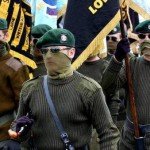
Republicans and Nationalists did not have a monopoly on paramilitary activity during the Troubles. Loyalists also formed paramilitary groups to defend Unionism, protect Protestant communities and respond to Republican violence. Like Republicans, Ulster Unionists had a history of taking up arms for political causes. Loyalist paramilitary activity dates back to the early 20th century when Ulster Protestants threatened civil war against a Dublin-based government. Loyalists paramilitary groups reformed in the 1960s, in response to the civil rights movement and growing unrest in Northern Ireland. The two largest Loyalist groups were the Ulster Volunteer Force (formed 1966) and the Ulster Defence Association (formed 1971). For three decades these groups did battle with the Irish Republican Army (IRA) and Catholic communities – and occasionally with each other. Loyalist paramilitaries employed similar methods to the IRA; their members displayed comparable levels of political fanaticism, violence and secrecy. And as with the IRA, many victims of Loyalist groups were often civilians caught in the crossfire or in the wrong time and place.
The first Ulster Volunteers
Militant Loyalism dates back to 1912 and the introduction of the Home Rule Bill into the British parliament. Home Rule horrified Ulster Protestants, who feared a Dublin-based government dominated by Catholics and Nationalists. Protestant communities in the Six Counties began organising their own civilian militias. In 1913 these militias combined to form the Ulster Volunteer Force (UVF). Under the leadership of Edward Carson and James Craig, the UVF threatened civil war if a Home Rule dominated by Catholics was imposed on Ulster. In April 1914 the UVF smuggled around 20,000 German rifles and millions of rounds of ammunition into Northern Ireland. The Home Rule Bill was passed in May 1914, further inflaming the situation – but the implementation of Home Rule was set aside due to the outbreak of World War I in August. Instead of taking up arms against Dublin, thousands of Ulster Volunteers enlisted for military service in Europe. Its numbers dwindling, the UVF faded away and was eventually demobilised in 1919. The UVF was revived briefly during the Irish War of Independence (1920-22) to respond to IRA violence in Ulster. Many of its members went on to joint the Ulster Special Constabulary (USC) or ‘B-Specials’.

The growth of the Catholic civil rights movement in the mid-1960s revived militant Loyalism in Northern Ireland. Two paramilitary groups were formed in 1966: the Ulster Protestant Volunteers (UPV) and the Ulster Volunteer Force (UVF). The UPV was a small Christian fundamentalist group, led by the Reverend Ian Paisley. The UPV is best remembered for bombing several power stations and water supply facilities in March and April 1969, as a protest against the Unionist government’s reformist policies. The UVF was of greater significance. This group was formed in May 1966, 50 years after Easter Rising. Loyalists were outraged by Nationalist celebrations of this anniversary and feared they might prompt a resurgence in IRA activity.
The UVF is reborn
A gang of militant Loyalists, barely a dozen strong at this point, decided to take action. In April 1966 they fire-bombed the Holy Cross Girls’ School, a Catholic primary school in Belfast. Northern Ireland prime minister Terence O’Neill was scheduled to attend a Catholic-Protestant reconciliation meeting at the school the following day. On May 7th Loyalists also attacked a Catholic pub in Upper Charleville Street. The resulting fire spread to a neighbouring building and killed one its residents, an elderly Protestant woman. The leader of these attacks was Gusty Spence, a former British Army sergeant and prominent Shankill Road hard man. On May 21st UVF leaders issued a statement:
“From this day, we declare war against the Irish Republican Army and its splinter groups. Known IRA men will be executed mercilessly and without hesitation. Less extreme measures will be taken against anyone sheltering or helping them, but if they persist in giving them aid, then more extreme methods will be adopted. We solemnly warn the authorities to make no more speeches of appeasement. We are heavily armed Protestants dedicated to this cause.”
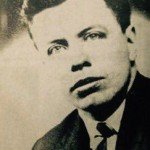
A week later UVF members were sent to assassinate Leo Martin, a Belfast IRA volunteer. When Martin could not be found they shot dead a Catholic civilian, John Scullion, he walked home from a night out. In June the UVF gunned down three men leaving a Catholic pub in Belfast, killing one. These murders came to define the UVF’s sectarianism, which too frequently failed to differentiate between Republican paramilitaries and civilians. Like John Scullion, many victims were selected at random because they were Catholic or in Catholic areas. In June 1966 the Northern Ireland government declared the UVF an illegal organisation and arrested Spence and three others. Spence was convicted of murder and sentenced to life in prison. He remained there until 1984, bar a brief escape in 1972.
The UVF rebooted its military activities in early 1969, supporting the UPV with its bombing campaign. Both sought to undermine the O’Neill government, which hardline Loyalists considered too conciliatory and friendly with both Catholics and Dublin. The UVF was active during the unrest and violence of August 1969, attacking Catholic communities and destroying property. In October a Loyalist gunman shot dead a Royal Ulster Constabulary (RUC) officer. Between August and December 1969, UVF members organised a wave of attacks in the Republic of Ireland. These attacks included the bombing of a television studio, a police station and infrastructure.
Some of the deadlier and more significant actions of the UVF include:
[expand title=”McGurk’s Bar bombing”]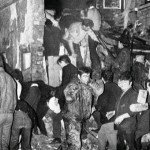
Just after 8.30pm on December 4th 1971 a bomb wrapped in brown paper was placed near the doorway to McGurk’s Bar, a Catholic pub in central Belfast. The bomb exploded shortly after, weakening the building’s foundations and bringing about its collapse. The blast and falling debris killed 15 people and injured 17 others, all of them Catholic. Among the fatalities were Philomena and Maria McGurk, the wife and teenage daughter of bar owner Patrick McGurk. Addressing the media later, Patrick McGurk pleaded for Republican groups not to retaliate. It later emerged that UVF bombers targeted McGurk’s Bar after failing to gain access to an IRA pub, their original target. McGurk’s was chosen, suggested one of the bombers, because it was the closest Catholic pub. This bombing came at a time of severe unrest and sectarian violence in Northern Ireland: there were more than 50 bombings in December 1971 alone. The initial police investigation found the blast was caused by a Provisional IRA bomb accidentally detonating; this was vehemently denied by the IRA and later found to be incorrect. In 1977 UVF member Robert Campbell was charged and convicted of the bombing and sentenced to life in prison.
Click to hear a BBC Radio news report on the McGurk’s Bar bombing
[/expand]
[expand title=”The Miami Showband Massacre”]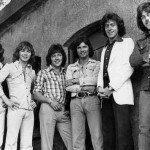
On July 31st 1975 UVF members carried out one of the most notorious murders of the Troubles when they attacked a minibus near Bushkill, County Down. Inside the minibus were members of the Miami Showband, a popular cabaret band from the Republic. The group was returning home to Dublin after performing in Banbridge, County Down. Their minibus was stopped at a fake checkpoint set up by UVF members and band members were forced to stand on the roadside while ‘military personnel’ checked their vehicle. The two men examining the minibus were, in fact, planting a bomb – but the poorly-prepared device exploded, killing both volunteers. The surviving Loyalists opened fire on band members, killing three men. The Miami Showband had both Catholic and Protestant members, no political affiliations and no connection to the Troubles. Historian Martin Dillon asserts that while the gunmen were all UVF members, at least three belonged to the Ulster Defence Regiment (UDR).
[/expand]
[expand title=”The Shankill Butchers”]The Shankill Butchers were a contingent of serial killers in Belfast in the 1970s. While not officially a unit of the UVF, the Butchers were staunch Loyalists and most were UVF members. The group was recruited and organised by Lenny Murphy, probably in 1975. Murphy was a petty criminal and notorious thug from the Shankill Road area of Belfast. Raised with a pathological hatred of Catholics, Murphy used the Troubles as an excuse for sectarian violence and murder. Under his leadership, the Butchers shot four Catholic bar workers in 1975. They were probably responsible for other unsolved killings and acts of violence. In November 1975 Murphy and his gang snatched 34-year-old Francis Crossen off the streets of Belfast. Crossen was driven back to Shankill, beaten relentlessly and had his throat cut. Between late 1975 and 1979, Murphy’s gang murdered at least 30 people. Most were Republican paramilitary volunteers or Catholics chosen at random, though some were Protestants accused of treacherous behaviour. Murphy himself was murdered by the Provisional IRA in 1982, not far from where the bodies of several of his victims were dumped.
[/expand]
[expand title=”The Red Hand Commando”]
The Red Hand Commando (RHC) was a UVF satellite group. It existed separately from the UVF but frequently carried out missions on its behalf. RHC founder Johnny McKeague was a notorious Catholic-hater, once aligned with Ian Paisley. Notoriously erratic and secretly homosexual, McKeague recruited young Loyalists from East Belfast to form the RHC. The group derived its name from the heraldic symbol for Ulster. Beginning in early 1972 the RHC carried out numerous bombings and drive-by shootings in Catholic areas. Officially the RHC was responsible for 13 deaths, though the true number is undoubtedly higher. Most of its victims were civilians. In October 1976 RHC volunteers entered a Belfast hospital dressed as doctors and assassinated Sinn Fein politician Maire Drumm, shooting her as she lay recovering from surgery. The RHC carried out assassinations of some members of rival Loyalist groups.
[/expand]
The Ulster Defence Association
“The UDA was formed out of the various local associations in the summer of 1971 and grew rapidly so that it could soon turn three or four thousand uniformed and marching men onto the streets. Although its public leaders maintained that the UDA was defensive, there were from the start members who thought the best form of defence was attack. The thinking was simple. The ‘Taigs’ had already got three-quarters of the island in 1920 and they were not going to get Ulster. The IRA is killing ‘Prods’; we will kill Republicans; if we cannot find Republicans we will kill Catholics.”
Steve Bruce, historian
The Ulster Defence Association (UDA) was formed in 1971 at the height of the Troubles. The UDA’s origins can be traced back to a group of pigeon breeders from the Shankill Road area. Angry at rising Nationalist violence and the disbanding of the ‘B Specials’ in 1970, these men banded together to form a local ‘defence association’. By late 1971 several of these associations had coalesced to form the UDA. In its first years, the UDA was commanded by Charles Harding Smith (like Gusty Spence, a former British soldier). The UDA grew quickly and by 1972 boasted around 30,000 members. The UDA presented itself as a legitimate organisation dedicated to lawful action (its motto was ‘law before violence’). Despite this, there were scores of active paramilitary volunteers in UDA ranks.
In mid-1972 the UDA formed a Loyalist paramilitary group called the Ulster Freedom Fighters (UFF). The UFF was ostensibly a separate group with its own leadership and organisation. In reality, the UFF was a cover for UDA members when carrying out paramilitary or terrorist operations. This separate structure allowed the UDA to remain legal, though the UFF was banned as a terrorist organisation in November 1973. The UDA/UFF was responsible for many brutal incidents during the Troubles, including:
[expand title=”Benny’s Bar bombing”]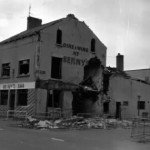
On October 31st 1972 UFF volunteers exploded a car bomb outside Benny’s Bar, a Catholic-owned pub in Sailortown, the non-sectarian docklands area of Belfast. The car was loaded with 45 kilograms of explosive, parked outside the bar then detonated in the early evening. The blast killed two Catholic girls, four-year-old Clare Hughes and six-year-old Paula Strong, who were dressed as witches and ‘trick-or-treating’ along Ship Street. A further 12 people were badly injured, including other children playing nearby. The bomb also destroyed much of the pub and damaged several houses along the street. The deaths of two innocent children caused horror and outrage, yet the UDA/UFF continued to attack Catholic pubs and businesses. Only three days after the attack on Benny’s Bar, UFF members crossed the border into the Republic of Ireland and bombed a pub there. On December 20th UFF gunmen attacked another Catholic-owned pub, this time in Derry, and shot dead five civilians.
[/expand]
[expand title=”The Milltown Cemetery attack”]
In March 1988 three Provisional IRA volunteers were killed by British commandos in Gibraltar while planning a bomb attack on British personnel there. A funeral for the three was held in Belfast eight days later. With tensions already high, hundreds of mourners – including prominent Republican leaders Gerry Adams and Martin McGuinness – followed the funeral cortege to Milltown Cemetery in Belfast’s Falls Road district. As the coffins were being lowered, two grenades were thrown into the crowd by Michael Stone, a UDA member who had infiltrated the funeral. Stone fled towards a nearby motorway, pursued by a group of mourners. As he ran Stone hurled grenades and fired bullets at his pursuers, killing three. The crowd eventually caught Stone and beat him unconscious, before Royal Ulster Constabulary (RUC) officers arrived and arrested him. Stone was convicted of the Milltown killings and three other murders and sentenced to 684 years in prison. There has been much debate about whether Stone, a trusted and successful UDA operator, carried out the attack as a free agent or with UDA backing. Three days later, two British Army corporals were captured, beaten and murdered by the Provisional IRA – after they mistakenly drove through a funeral procession for one of the Milltown victims.
[/expand]
[expand title=”The Bookmakers’ Massacre”]
In February 1992 two UFF volunteers wearing balaclavas entered the Sean Graham betting shop in Ormeau Road, Belfast. They opened fire on the crowded shop, firing 44 rounds from an assault rifle and a pistol. Five people were killed and another nine were wounded. All were Catholic civilians with no known links to the IRA; the youngest victim, James Kennedy, was just 15 years old. UDA members later suggested the attack was a retaliation for the IRA’s Teebane bombing a fortnight earlier, which killed eight Protestant construction workers. Nobody was arrested or convicted for the betting shop attack, though two prominent suspects were gunned down by the IRA two years later. In November 1992 the UFF attacked another betting shop in a Catholic area, this time in Oldpark Road. Three people were killed in this attack.
[/expand]
Other Loyalist groups
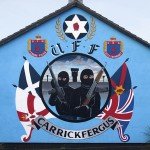
There were numerous smaller Loyalist groups active during the Troubles, some of them splinter groups or young branches. Ulster Resistance was formed in late 1986, fuelled by Protestant opposition to the Anglo-Irish Agreement. Backed by Ian Paisley and boasting several thousand members, Ulster Resistance carried out bank robberies and used the funds to acquire a large cache of weapons from the Middle East and South Africa. It used these weapons to supply the UVF and UFF, rather than carrying out its own operations. The Young Citizen Volunteers (formed 1972) and the Ulster Young Militants (formed 1974) were the youth wings of the UVF and UDA respectively. Both engaged in vandalism, sabotage and thuggery against Catholics and their property. According to statistics compiled by Malcolm Sutton, Loyalist paramilitary groups were responsible for more than 740 deaths during the three decades of the Troubles. The UVF was the deadliest of these groups, carrying out 481 killings, while the UDA/UFF was responsible for 260 deaths.

1. The formation of Loyalist paramilitary groups dates back to the Ulster Volunteers, an armed militia that resisted the move towards Home Rule in 1913-14.
2. Loyalist paramilitaries reemerged in the mid-1960s following the 50th anniversary of the Easter Rising and the emergence of the civil rights movement.
3. The Ulster Volunteer Force was led by Gusty Spence and formed in the spring of 1966 when it launched indiscriminate attacks on Catholics.
4. The Ulster Defence Association and its military wing, the Ulster Freedom Fighters, emerged in the early 1970s.
5. These groups attacked suspected Republican paramilitaries, prominent Nationalists, randomly chosen Catholic civilians and occasionally each other. Loyalist paramilitary groups killed more than 740 people during the Troubles.

The UVF calls for the formation of volunteer platoons (1971)
The Sash My Father Wore (Loyalist song)
The Men Behind the Wire (Loyalist song, 1972)
© Alpha History 2018. Content on this page may not be republished or distributed without our express permission. For more information please refer to our Terms of Use.
This page was written by Rebekah Poole and Jennifer Llewellyn. To reference this page, use the following citation:
R. Poole and J. Llewellyn, “Loyalist paramilitaries: the UVF and UDA”, Alpha History, accessed [today’s date], https://alphahistory.com/northernireland/loyalist-paramilitaries/
